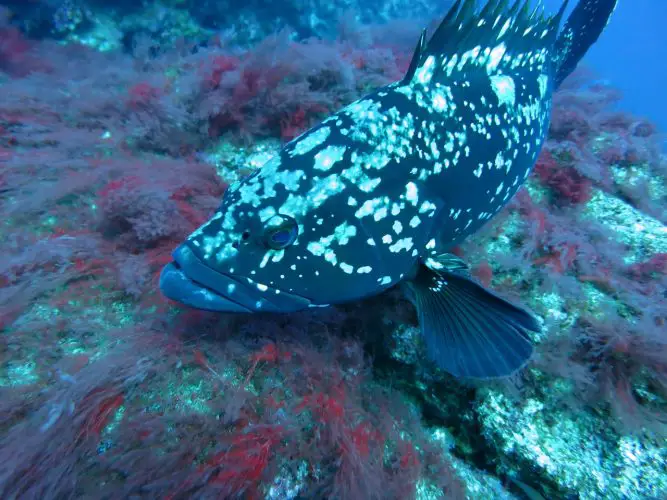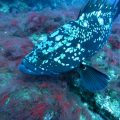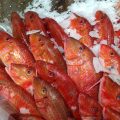Grouper are among the largest species in the Atlantic Ocean, and it weighs up to 800 pounds. Generally, groper is primarily found in shallow tropical waters between artificial and coral reefs. They are big, built for long-distance, length of more than one meter, and fast swimmers.
1. What do grouper eat?
Grouper are a carnivorous fish that tend to grow faster compared to others related. They tend to swallow prey instead of biting small pieces of it. Besides, grouper do not have teeth right on their jaw edges but have strong crushing teeth plates intimate the pharynx. The grouper’s stomach content examination documented that around 85 percent of their initial diet comprises crustaceans, mainly crabs. Further, the remaining 15 percent basically consists of slow-moving fishes like catfish, burrfish, and toadfish.
Alongside looking at grouper stomach contents, which offer a short-term view of everything a grouper, ate before captured. The scientist again examined grouper diet extensive term utilizing a sophisticated analytical technique known as isotope analysis. In essence, this measured the relative concentration of specific molecules like carbon and oxygen in the body tissue to aid scientist understands links in a grouper food web.
The results showed that grouper occupy a relatively low position on the food chain, almost the similar level to small pinfish. And this result concluded that grouper’s do not typically eat superior level of predators like snappers.
http://www.bio.fsu.edu/coleman_lab/documents/Koenigetal_2011_GG_recover (BMS).pdf
2. When do grouper eat?
Groupers usually forage for their food during daytime and are inactive during the night. Their gills and mouths form a robust system that sucks their prey from a distance and use their giant mouths to eventually create more negative pressure to swallow the large invertebrates or whole fishes efficiently and quickly. They engulf the prey whole by dilating their robust gill covers and promptly draws in current water, inhaling the food.
3. The nursery and feeding habitat of a grouper
Mangroves critically serve as the nursery habitat of groupers. The newly small groupers are mostly found feeding in mangrove leaf litter and long mangrove shorelines. The adult groupers tend to remain at one specific site for a more extended period; thus, they usually eat the slow-moving small fish moving around.
The small groupers are also Teleosts and habitually eat octopuses, fish, and crustaceans. Some groupers prefer ambushing their target feed while others are very active predators. Additionally, the goliath groupers prefer resting in coral, rock, and mud bottoms. This fish is solitary by its nature, and it stays in refuge wrecks, ledges, and caves with its mount open and quivering its body to intruders.
4. Do seasons changing affect grouper feeding?
Most likely yes, as the seasons change, grouper feeding habits change. They are cold-blooded and typically take the cure to different water temperatures. For example, at a temperature of 70 and above, grouper is active and ready for their summer diet. However, when the temperatures become low, grouper seem to slow down to get ready to go dormant for the winter.
Grouper craves a protein-rich diet and that is why they mostly fed on other related small fish. Since this offers them nutrients, they require adding mass and growing. Grouper lack the essential digestive enzymes necessary to break down their summer food in spring.
After a grouper swallow, a big prey can stay for a long time without hunting for more food. They spend more of their time hiding deep on rocks or caves for digestion to take place at this specific time.
Groupers begin their life as females, and they sexually mature after reaching 4 and 6 years of age. Some of them can later transform to males, frequently between the ages of 7 and 17 years. Groupers, such as, the red grouper are rated among the top predators in the reef community food webs and can control some specific aspects of community balance in the reef systems.
Further, they are opportunistic and unspecialized feeders, meaning they can eat any convenient prey. Additionally, because groupers move from one habitat to another, every life stage has different necessities for being successful. Occupying various niches relative to their position and size affect their food web, regardless of whether they eat bottom-dwelling crustaceans, plankton, and other related fish.
5. How much does a grouper feed?
As I discussed earlier, groupers are large species, and some would want to know how often they feed in a day, week, or year. A study was conducted on three different groupers, and because of their depth and size, they were conditioned to typically feed on the aquarist. The daily food logs were recorded, comprising the number and type of species, how often they accepted to be offered food, and how often they fed.
Over one year duration, records showed that group 2 had a higher degree of difference in its monthly feeding, and the grouper in 1 and 3 ate consistently the whole year. And this concluded that some groupers eat inconsistently while others eat often. Small groupers will typically eat small often while massive ones eat once over a short period. https://doi.org/10.1002/zoo.20209













Pingback: Do Grouper Eat Jellyfish? | Reel Fishing Guru
Pingback: How do Groupers Breath? | Reel Fishing Guru
Pingback: Do Groupers Have Teeth? | Reel Fishing Guru
Pingback: How Deep do Groupers Live? | Reel Fishing Guru